
But the oddest manifestation of deer season, culturally speaking, would have to be the hunting carols. That phenomenon is exactly what it sounds like. Every year, all of our local radio stations, regardless of format, slipped two hunting-themed tunes into their regular playlists. For two weeks a year, “The Second Week of Deer Camp” and “Da Turdy Point Buck” dominated the airwaves just as surely as “The Little Drummer Boy” and “Feliz Navidad” would a few weeks later.
“The Second Week of Deer Camp” is a venerable classic, an accordion-driven, ramshackle accounting of how a bunch of shiftless hunters spend the titular time period. (Spoiler: They “drink, play cards and shoot the bull, but never shoot no deer.”) This one has been getting major play on Wisconsin airwaves for two decades now, even though the band responsible, Da Yoopers, isn’t technically Wisconsinian. “Yoopers,” in fact, is a nickname for the residents of that eerie no-man’s land called the Upper Peninsula, more commonly known as the U.P. Technically speaking, it’s part of Michigan. Geographically speaking, it should be part of Wisconsin. Realistically speaking, it’s not much more than an afterthought for anyone but the people who live there and the scads of hunters who invade its teeming woodlands every November.
Anyhow, Da Yoopers have actually recorded a fair number of musical comedy albums and garnered a cult following in the upper Midwest. “The Second Week of Deer Camp” is arguably the shiniest jewel in their crown (their Christmas carol “Rusty Chevrolet” also gets a good bit of airplay come December). An amiable romp through a drunken week when most of the sportsmen have given up all pretense of actually hunting, the song is punctuated by frequent belching, Spike Jones-y sound effects and some unfortunate outhouse imagery. The action, such as it is, unfolds over a simple accordion rhythm and is narrated in a thick Northwoods accent that makes Fargo seem subtle. It’s appreciated both by hunters who don’t take themselves too seriously and by the folks at home who always assumed there wasn’t a whole lot of deerstalking going on. It’s lowbrow for sure, but the rhymes are pretty funny and it succeeds in making a week of drinking in a cabin sound like a lot of fun.
If “Deer Camp” is the tried and true classic, “Da Turdy Point Buck” was the glitzy blockbuster. Often mistakenly credited to Da Yoopers, this laconic rap parody is actually the work of another U.P. group called Bananas at Large. A loose narrative of one hunter’s ill-fated encounter with a deer “created by God just for outdoor magazines,” this song was absolutely unavoidable in Wisconsin the winter of ’92. The cassette single – packaged in a blaze orange label, naturally – never got widespread distribution, but it was available at all of your finer gas stations and convenience stores.
The song essentially takes every element of the Yoopers tune and cranks it up a little: the accordion accompaniment is even sparer, the accent even thicker, the belching even ruder. In other words, it contains all the elements of a Wisconsin cult classic. Most of my middle school classmates (the male ones, at least) could recite the “Turdy Point Buck” lyrics word for word, adopting a deep-woods ‘Sconnie accent that really wasn’t too far removed from the way most of us talked normally. In fact, listening to the original recording now, I realize the cadence I’ve stored in my memory banks is actually that of Tim Schendel regaling me with his version during lulls in Mrs. Gatzke’s Earth Science class. I can’t deny that I loved it wholeheartedly when I was a youth, or that some of the imagery has proven remarkably enduring. Living in Chicago made me especially appreciative of the passage about the narrator’s “no-brother-good-in-law… from Illinoise.” (No offense to my actual brothers-in-law in Illinois.)
Putting it in hip-hop terms, “The Second Week of Deer Camp” is “Fight the Power” and “Da Turdy Point Buck” is “U Can’t Touch This.” The former feels lived-in and true-to-life, while the latter is just kind of derivative and silly. “Buck” is probably the more widely known amongst Midwestern rifle-toters, but both have worked their way deep into the fabric of Wisconsin’s holiest holiday.
Don’t think I’m being dismissive of either. In their own way, these hunting carols represent a unique piece of Midwestern culture. They’re a bit of a throwback to the early days of rock and roll, when radio stations were allowed to choose their own playlists and it was possible to have such a thing as a regional hit. Sure, these songs fall quite a bit farther on the Blue Collar Comedy side of the spectrum than my usual tastes, but I like having a pop culture reference point that’s instantly recognizable to every one of my rural grade school classmates and completely foreign to my big city friends. Call it flyover country all you want, but we’re every bit as capable of producing a distinctive musical mythology as anyone else is. Ours just involves a bit more beer and deer than most.
Saturday, November 28, 2009
Of hunting carols, Turdy Point Bucks and the cultural currency of the Upper Midwest
Sunday, November 22, 2009
Of Virgil Trucks, the Detroit Tigers and the meaning of life
 I think it’s generally agreed upon that sports metaphors are more overused than the Cleveland Browns’ punting unit. Rare is the modern business meeting that does not include a mention of tossing Hail Marys, sending in the B-team or making a game-time decision (I’ll admit to being a frequent abuser of that last one). Hackneyed or not, these metaphors serve their purpose. It’s a little easier to pretend that life makes sense when it’s framed in the context of an organized athletic competition. Plus, describing an overly complex planning session as “having 12 men on the field” will get me many more knowing nods than will comparing it to the audio track of an Altman film or the first half of The Sound and the Fury.
I think it’s generally agreed upon that sports metaphors are more overused than the Cleveland Browns’ punting unit. Rare is the modern business meeting that does not include a mention of tossing Hail Marys, sending in the B-team or making a game-time decision (I’ll admit to being a frequent abuser of that last one). Hackneyed or not, these metaphors serve their purpose. It’s a little easier to pretend that life makes sense when it’s framed in the context of an organized athletic competition. Plus, describing an overly complex planning session as “having 12 men on the field” will get me many more knowing nods than will comparing it to the audio track of an Altman film or the first half of The Sound and the Fury.
And sometimes a sports metaphor can be more than just convenient. I’m thinking specifically of Virgil Trucks’ 1952 season with the Detroit Tigers, a campaign that I believe may provide me with a model for life itself.
Virgil Trucks has led a pretty interesting existence by just about anybody’s standards. A native of Birmingham (reputedly the greatest city in Alabam’), Trucks was a Major League pitcher for 17 years. He played in two All-Star games, brought home a World Series ring in 1945 and almost certainly would have won a Cy Young Award had it existed in 1953, when he finished fifth in MVP voting. He also served honorably in the Navy during WWII and even has a tangential connection to the modern jam band phenomenon: Virgil is the uncle of Allman Brothers drummer Butch Trucks and the great-uncle of guitar-slinger Derek Trucks.
That's all well and good, but I choose to cherish one of Trucks’ more ambiguous achievements. You see, in 1952, Virgil Trucks finished with a disappointing record of 5-19. Two of those wins, however, were no-hitters. Throwing one no-hitter is a rare feat. Throwing two in a season is something only four men have ever done. And throwing two in a decidedly losing season is my new ideal.
As I see it, in the game of life, there’s not much point in playing to win. Hard work and good intentions will only get you so far. Ultimately, the breaks are going to fall for you or against you, and you really don’t have much say in the matter. You can change up speeds, try a different grip on the ball, even file it down with an emery board in your effort to win, but the odds are that you’re going to rack up plenty of losses and no-decisions.
Some people are going to find a groove and pull off something spectacular, like Denny McClain’s 31-6 season with the ’68 Tigers. I don’t believe I know anyone personally who fits this profile, but I’m sure they’re out there. Other people are helpless to do anything but watch the losses pile up, like Adam Bernero’s 1-12 2003 campaign. This is how I picture life for that poor Star Wars kid from the YouTube video, or those guys who are always smoking cigarettes outside the weekly-rates hotel up the street from me. Those scenarios are, I think, beyond anyone’s control. Winners win, losers lose, but I don’t think many people fall completely in either category.
It seems like most people dedicate their lives to breaking even, like Paul Foytack going 14-14 for the 1959 Tigers. It’s not necessarily a bad goal. Closing out a season with 14 wins is pretty impressive. Losing 14 games isn’t great, to be sure, but at least you didn’t finish below .500. For a lot of folks, that’s enough. But me, I’m not content with aiming for the middle.
To me, what Virgil Trucks accomplished in that 5-19 effort is far more impressive. 19 is a lot of losses, and Trucks had enough success in his past that I guarantee every one of those blown games stung like hell. There must have come a point when he realized that his 1952 season was a wash-out, that there was no hope of him turning it around and posting a winning record. From that point on, I bet even the wins felt bittersweet, a reminder of what good pitching was supposed to feel like, and what it wouldn’t feel like until at least the start of the next season.
As a writer, that’s how I feel every time a rejection letter arrives in the mail, or a form e-mail from a literary agent shows up in my inbox. I count my losses with every story that writes itself into a corner, every line of dialogue that sounds embarrassingly stilted when read aloud, every scene that plays great in my head but falls flat on paper. Expand the metaphor to life in general and I could rattle off an endless litany of losses both tangible and intangible. Sure, I have some wins under my belt – more so than a lot of people, if I’m honest with myself – but most days the won-loss record feels even more lopsided than Virgil Trucks’ 5-19.
What pulls me through are those two no-hitters. Sure, 1952 was a lousy season for Virgil Trucks, but twice that year he achieved something very close to perfection. In those two games, he accomplished something that only a handful of human beings have ever done. The feeling he must have had when he recorded the last out of his first no-hitter is something few of us can conceive of. The feeling after the second one must have been indescribable.
That’s what I want out of life. I want my two no-hitters. Sure, it would be great to post a winning record too, but if tossing my gems means I lose in the long run, so be it. I will suffer my defeats with gratitude, so long as they’re in the service of two moments of ultimate, near-flawless success. Until then, I can only hope the sun keeps shining, my pitching elbow stays strong and the league doesn’t go on strike.
Monday, November 9, 2009
"Confessions of a video virgin" or "What's in the boooox?"
For someone who grew up to be a fairly devoted cinephile, I was a pretty sheltered kid. I grew up in the country, in a converted grain barn half a mile from the nearest paved road. We got four, sometimes five channels on our fuzzy 19-inch TV, depending on the weather. (Even if we’d had the money for cable, I don’t think our local provider delivered that far out.) We didn’t own a VCR until my great uncle gave us a hand-me-down RCA behemoth when I was around 12. Before that, we’d occasionally rent a video player and a stack of movies as a weekend treat. My selection was pretty limited, as my parents were very dutiful about keeping my brother and me on a righteous path and protecting us from the uglier side of the entertainment industry. There were a lot of re-watchings of the Star Wars trilogy, Yellow Submarine and old Laurel & Hardy shorts.
The point I’m very gradually getting to is that I didn’t see horror movies as a kid. The closest I came was when the local Fox affiliate showed a week’s worth of those Abbott & Costello Meet the Mummy/Frankenstein/The Invisible Man movies one summer, but there wasn’t much resembling genuine scares in those. I didn’t see a bona fide horror film until my fifth grade field trip to Washington, D.C., when someone played the not particularly terrifying The Lost Boys on the bus-wide video system.
You’d think that this combination of protective parenting and backwoods exile would have kept me ignorant of the horrors of Hollywood. Quite the opposite, actually. In the grand childhood tradition of yearning for that which is forbidden, I became obsessed with horror movie video boxes. Every time we took a trip to the video shop or the grocery store, I couldn't help myself from lingering in the horror section, where out-of-context imagery from all sorts of '80s trash played hell with my fragile, Christian psyche. I had no idea what the actual movies were like – and I had no real desire to find out – but there was more than enough evil stuff going on on the covers to keep me wide awake at night, listening to the coyotes howl in the valley (seriously, we were hill people).
I was reminded of all of my video box nemeses recently when The AV Club ran a Halloween feature on “Entertainment that terrified us.” That inspired me to seek out some of the old nightmare fuel and see just how much of the terror holds up. I was plagued by dozens and dozens of covers back in the day, but these are a few that stand out as the worst offenders.
House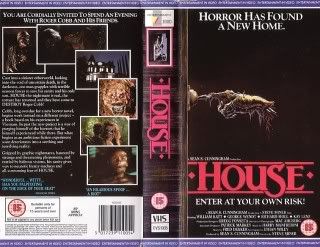
I think what got me about this one was the ambiguity of it. Whose severed hand was that? What business did it have with the residents of the titular house? How the hell did it float like that? I lost a lot of sleep coming up with answers to all of those questions. It didn’t help any that the artwork reminded me of the illustrations in those Scary Stories to Tell in the Dark books, another reliable source of middle-of-the-night terror. The dangling veins and tendons made me look down at my own skinny wrists and reflect on how fragile a thing the human body really was.
Current take: I’ve never seen House, but looking back, it seems silly to have been scared of anything that prominently featured George Wendt.
The Nightmare on Elm Street movies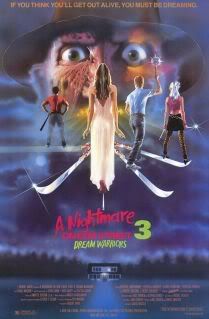
I think most of my classmates had similarly sheltered existences, but in a school as small as Leon Elementary (Fewer than 100 students, grades 1-6), pretty much everything is a community experience. Just the images of Freddy Krueger’s claws and scars would have been enough to freak me out, but mixing them with Brian Brooks’ vivid descriptions of Freddy’s various eviscerations created a potent cocktail of dread.
Current take: I’ve seen a few of these as a grown-up. They’re pretty fun, really. Wes Craven at the top of his game can craft a damned entertaining horror flick, and Robert Englund’s performance as Freddy is deservedly iconic.
Firestarter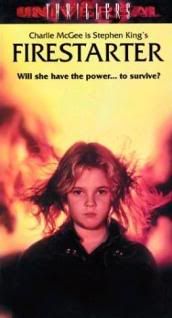
I really couldn’t tell you what disturbed me so much about this cover. There’s nothing inherently scary about it. For some reason, though, I found the image of little Drew Barrymore glaring intensely while some sort of inferno erupts behind her deeply unnerving. Obviously, something terrible has happened to push her to this point, and whatever she’s doing is going to lead to even worse things. I know some kids would have found the idea of a girl their own age being able to wreak havoc on the adult world exciting and liberating. Me, I never got the whole resentment of grown-ups shtick. Grown-ups made my meals, got me to school and kept me safe from the evils of the world. Why would I want to give that up?
Current take: I caught Firestarter on TV a while back. There was nothing to be afraid of – it’s really more of a thriller than a horror film. I was surprised at how much I liked it. I might even call it the best performance of Drew’s career.
Basket Case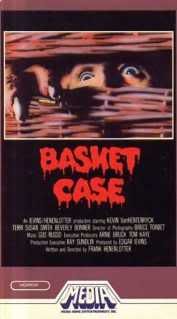
Once, when I was around eight or nine, we were at my parents’ friends’ house and I stumbled upon their teenage son’s stash of comic books. The first story I flipped to involved a soldier waking up from surgery to discover that his arms and legs had been amputated. There was a full-page splash panel of the terrified man reaching his bandaged stumps up to the ceiling and screaming, “What did you do to me? I’m a BASKET CASE!” I shut the comic right there and went home that day with a shiny new disturbing image to worm around in my brain. From then on, the Basket Case box was a double-whammy for me. I was mortified both by the slimy claw creeping out of that wicker basket and by flashbacks to that unfortunate soldier in some unknown ‘80s horror comic.
Current take: I recently watched Basket Case and rather loved it. It’s a perfectly sleazy little slab of exploitation cinema, the way mama used to make it.
Mother’s Day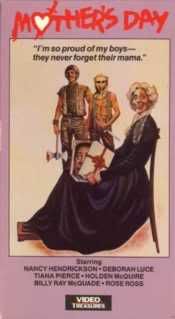
OK, this one still makes me shiver a little bit. There’s something about the combination of that grinning, skull-faced old lady, her freakish sons and the frozen scream on the lips of that decapitated head that moves beyond horror and into the realm of pure sadism. This one didn’t scare me so much as fill me with an existential dread. I’d heard and read enough stories about real-life serial killers to know that this kind of evil did exist in the world. I was still at the age of wanting to believe in the inherent goodness of humanity, and the smirking cruelty of this video box called that into question.
Current take: From what I’ve heard about Mother’s Day – it was one of my wife’s traumatic childhood movies – it’s every bit as brutal as I’d imagined it. I like a good horror film, but I don’t take kindly to rape and torture.
Xtro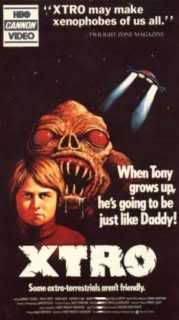
Why was Xtro my number one video box bogeyman? It’s hard to say. Looking at it now, it’s by far the cheesiest of any of these images – just a badly drawn alien juxtaposed with a serious-faced little boy. I think what really got to me was that tagline. I interpreted that to mean that the boy on the box was going to slowly turn into the abomination behind him. There was something about unholy transformations that shook me to my very core. I was also frightened by the pull quote from Twilight Zone Magazine (seriously) about Xtro making xenophobes of us all. Not knowing the definition of “xenophobe,” I used context clues to surmise, ironically enough, that it was the name of an alien race. The notion of everyone I knew and loved being transformed into slathering space monsters invoked terror on par with the Book of Revelations for me.
Current take: I’ve never seen Xtro – I’m not even sure if it’s available on DVD – but I’ve heard it’s pretty laughable. I kind of want to watch it and I kind of don’t. I’m pretty sure the real thing wouldn’t live up to my nightmare visions, and some part of me wants to preserve my boyhood fear. In a weird way, it’s sort of comforting.
Tuesday, November 3, 2009
Five things I have never said to myself upon finishing a John Irving novel
 1. "Is there a more fascinating narrative sport than collegiate wrestling?"
1. "Is there a more fascinating narrative sport than collegiate wrestling?"
2. "If only he were less ambiguous about his feelings for Charles Dickens."
3. "You can never have too many queasy rape scenes."
4. "I wish there'd been a little more deus in that machina."
5. "Needs more bears."
(Photo courtesy of this interview)